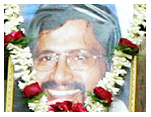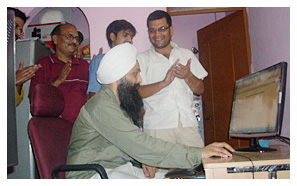 At a recent opening for a friend’s art show in Delhi, I was asked to stand aside while a small group photo was being taken. A local photographer was covering it for his newspaper, and was under explicit instructions to photograph only those who had paid the requisite fee for the Page 3 slot.
At a recent opening for a friend’s art show in Delhi, I was asked to stand aside while a small group photo was being taken. A local photographer was covering it for his newspaper, and was under explicit instructions to photograph only those who had paid the requisite fee for the Page 3 slot.
So blatant was the commercial angle to the page that the photographer was under quite some strain to weed out the non payers, though he could as well have edited them later in Photoshop.
Newspapers today make no pretence of selling out. Some years earlier papers started tentatively placing half page ads on the front page to test if the public would notice the change. It didn’t. Soon enough, ads became bigger, more colourful, and began to bleed into the text. Newspaper headlines and lead stories shrunk to accommodate the new demand. When business houses wanted bigger ads and were willing to pay, editors gave in, quietly and without fuss.
Some readers may have noticed that former Prime Minister Gulzari Lal Nanda’s death could not be covered because Colgate and Coke had both given full page ads that day. Editors went so far as to request the Nanda family to postpone the death by a day, but Nanda, being an obstinate politician, carried on with his original plan; his death was a two line obituary below an oversize Coke bottle. But that was long ago.
Contrast : Today every paper comes coated front and back with commercial space. When only half a page ad is sold the paper comes cut in half. Try holding a half paper in your hand along with the morning cup of tea. And you’ll know the real power of commerce.
At the other end of the spectrum is news coverage by Doordarshan . A wooden mouthpiece reads the day’s news in a DD board- approved monotone. Without fuss, you will learn that an overloaded Himachal state bus with 78 on board plunged down a gorge in Kangra district, killing all 160 passengers and injuring 30. Of the 52 people who died 12 were children and the other 67 were adults. The driver who was watching a movie at the time of the crash, is currently absconding to Pathankot to finish the rest of the film. India’s winning 5 Nobel Prizes, or the President’s sudden assassination will be conveyed with the unsentimental appeal of a mannequin in a shop window.
Compare the same story on a private news channel, and you will quickly realise the value of monotony. First, for bus accidents, melodramatic music will create the sombre mood. The camera will be tilted to show that it is the work of a cameraman who is at heart an artist. And before long, the TV anchor will switch to ‘ our correspondent Saraswati, at the site of the gruesome accident’. Even though Saraswati is a full time paid employee of the channel, she will be welcomed with a ‘thank you so much for joining us’ from the anchor. And Saraswati is already searching amongst the rocks in the gorge for signs of life to conduct a heartfelt interview with one of the willing dead. There is a perennial emotional backlash to any interview of a tragedy.
So insistent are the networks on trying to outdo each other in the coverage of the dramatic events, that something like a bus accident will have swarms of teary eyed reporters hanging around dead bodies, to show their keen involvement in the task.
Issues : To be fair though, media actions in the last few years have acted as a national conscience to weed out the corrupt and inept; the painstaking and fearless ways in which television and newspapers have conducted sting operations and meticulously exposed every detail or misdemeanour is a true credit to the profession. In a country where the judiciary, the police, the bureaucracy need serious reform, the media’s daily output on their misdeeds needs to be applauded. I for one have no qualms with the substance. My grief is with style.
First, the self- importance attached to editorial views is an increasing irritant in papers and magazines that insist on carrying the photo of the writer. In a story like this, why does my picture need to appear? Does it give greater insight to the discussion when the writer is glaring at the reader? Some newspapers go so far as to give full dress portraits of their contributors, as if their sartorial sense and bodily stance will give added weight to the message.
The second unfortunate thing is the inability of the networks to restrain the use of available technology. So overblown and exaggerated is the graphic presentation, it has the perennial appearance of a Punjabi wedding gone wrong. The screen is littered with simultaneous information displayed in a design mismatch so eccentric, it is impossible to focus. A main story above, BREAKING NEWS below, company market figures in continuous baseline movement, cricket scores in one corner, borrowed picture credits in another. Needless outlining, fade in and out and flashing. 12 people in separate boxes participate in TV discussions, of which eight speak simultaneously; the moderator screams himself hoarse trying to get the other four to also shout.
Plagued by commerce, infatuated by technology and clearly incapable of restraint, the results are despairing and mediocre. Excessively emotional correspondents, editorialised and personal news stories, and an imbecilic reverence to commerce make media offerings a minefield of uncertainty. You tread cautiously, hoping to pick out something of value in a shoppers stop of journalism. Disjointed movement from one incomplete story to the next, leaves the viewer exhausted and willingly returning to the more placid Doordarshan mannequin.
Formula : In the world of formula journalism, where fight for commercial space is the final frontier the selling of success is equivalent to the success of selling. The formula is simple: Start with a freewheeling interview with Shah Rukh Khan. Ensure that Shah Rukh Khan gets full coverage at the Kolkata Knight Riders’ match. And follow it up with a few ads for Skin Whitening Cream by Shah Rukh Khan. When Shah Rukh Khan is in town to open a new coffee outlet, give it full coverage. If Shah Rukh Khan is not in town to open a new coffee outlet, invite him to town to open a new coffee outlet. You won’t regret it. Throughout the day, bring in a story or two about Shah Rukh’s harassment at US immigration, ending the day with a movie starring Shah Rukh Khan….. Switch to Aishwarya Rai the next day in the same sequence. The formula will ensure high TV ratings.
Of the more serious flaws of Indian magazine, newspaper and television journalism is the unfortunate use of the commercial American media as a model: The New York Times , Wall Street Journal , Time Warner, Rupert Murdoch, business tycoons and media moguls mixed in a starry Hollywoodish light. Blighted by commerce, the world’s markets – US, Western Europe, Japan and the Far East are desperate commodities. Everything is on sale or rent or lease. Just the way newspapers are all ads and little substance; just the way sports revenues come from sponsorship rather than sporting display, and Hollywood films need to be sold before they can be made, even architecture and city space is a noisy neon- ridden ‘ Times Square’.
Many professions are today seeking a reprieve in under- development. Architects and urban designers are looking to cities of Eastern Europe and North Africa for work and ideas that aren’t blemished by commerce. So too are artists and writers. The more successful NGO work is coming out of places as diverse as Cuba and Brazil. Are Doordarshan , Pravda and the Budapest Times the only models left of the old journalism?
Courtesy: Mail Today















Cheap UGG
October 31, 2011 at 7:51 pm
[url=http://www.cheapuggoutletonlinestore.com/]Cheap UGG[/url] is one of those items that every girl out there should have in their wardrobe. UGG Boots are likely to be the most comfortable footwear you will ever own and what’s even better is that they look spectacular with almost every outfit. Here at Schuh we are delighted to be an official stockist of genuine UGG Australia boots and our collection features the UGG Classic short and tall, the UGG Cardy and the [url=http://www.cheapuggoutletonlinestore.com/]UGG Boots Clearance[/url].
hollister outlet
November 1, 2011 at 9:55 pm
Young people love the [url=http://www.hollisteroutletsale.org/]hollister sale[/url] hollister sale and [url=http://www.franklinandmarshalloutlet.org/]franklin marshall outlet[/url] franklin marshall outlet very much.These two brand clothes are so popular in the young people.